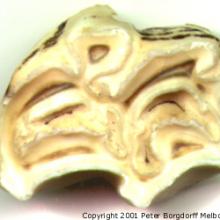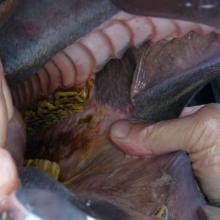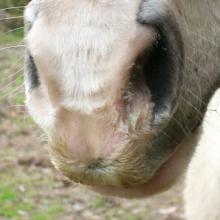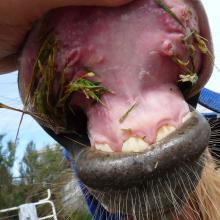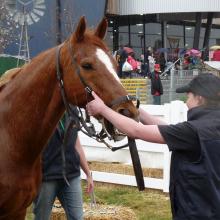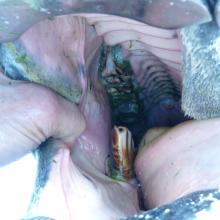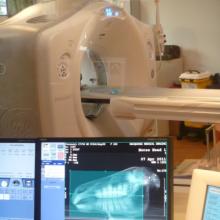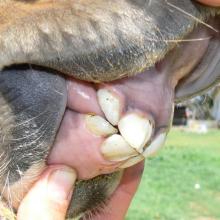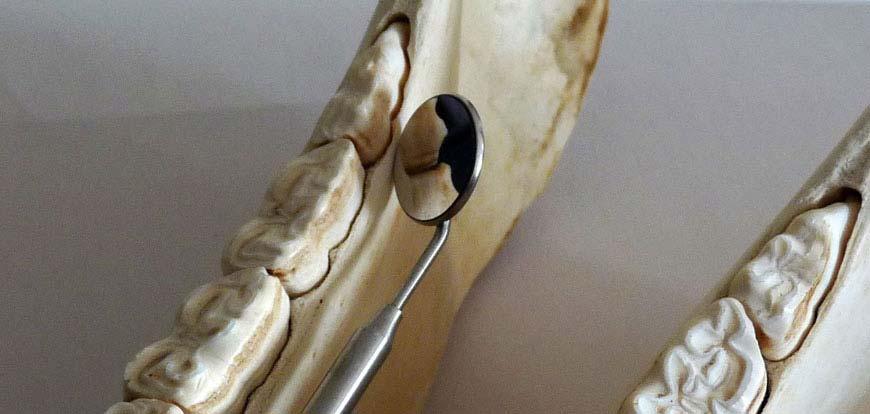
This text has been adapted. It was originally written by Peter Borgdorff for an information leaflet for the VEDA (now known as the EDAA)
HOW MANY TEETH DOES A HORSE HAVE?
From the age of 6 months onward, a horse will have between 36 and 42 teeth consisting of:
- 12 incisors (front teeth) which are used for grasping grass which then allows the horse to tear off that grass. Contrary to common belief, they are not used for cutting feed. All 12 incisors first erupt as milk teeth and are replaced by larger permanent incisors.
- 24 back teeth (premolars and molars) in 4 arcades of 6 grinding teeth. The first 3 teeth in each arcade erupt as milk teeth. The molars (i.e. premolars and molars) are used to finely grind the feed before it is swallowed. For this purpose, the molars have rough enamel ridges.
- 4 canine teeth located between the incisors and the molars. They are occasionally referred to as 'bridle teeth' and erupt at about 5 years of age in the male horse and are usually absent or very small in the female. The canines are often confused with wolf teeth.
- 2 wolf teeth positioned just in front of the upper molars. They are very small and are in most cases extracted by the Equine Dentist when ready because they can cause problems with the bit when they become decayed. Occasionally an additional 2 wolf teeth can be found in the lower jaw.
WHY DO THE HORSE'S TEETH REQUIRE REGULAR FILING?
Unlike our teeth, the horse's teeth continue to erupt during most of its life. Their dentition has evolved to grind large amounts of long, coarse fibre. In their natural environment horses are able to consume enough of this type of forage to wear their teeth evenly. The upper molars (grinding teeth) are wider than the lower molars and are set further apart than the lower molars. This causes grinding surfaces to have be angled downwards from tongue to cheek. Because feed is much different today, the teeth wear differently and the outside edges of the upper molars and the inside edges of the lower molars can become very sharp. These sharp edges need to be correctly filed to prevent damage to the cheeks and tongue. Additionally, where there is the common problem of abnormal wear this can be remedied by regular filing. The equine dentist must preserve grinding surfaces.
HOW DO I KNOW IF THE HORSE HAS TEETH PROBLEMS?
In many cases owners cannot tell whether a horse has dental problems. Gum disease, step mouth and wave mouth, for instance, are often developing at a young age with few symptoms, but may become horrific problems when the horse gets older. However, it will help if you routinely observe the horse when it is ridden (or driven) and when it is eating. Typical things to look for: Head shaking, head tossing, pulling to one side, hanging, being hard to turn, blood on the bit, spilling feed whilst eating, opening the mouth and at the same time crossing the jaws whilst attempting to masticate feed, excessive salivation, poor appetite, bad smell from the mouth, colic, undigested feed in the manure, coughing and many other symptoms.
WHEN DO "CAPS" NEED TO BE REMOVED?
Between 2 1/2 and 4 1/2 years of age the horse loses 24 milk teeth or deciduous teeth which are also known as 'caps'. The Equine Dentist will only remove them when due to be shed as the stable fed horse will often have trouble losing these and can develop abnormal dental wear as a result. Horses will have much less trouble shedding deciduous or milk teeth when they are solely on a grazing diet.
WHAT SORT OF FEED IS BAD FOR THE HORSE'S MOUTH?
There are many different types of feed that may cause injury to oral tissue. It is important to consult publications regarding this problem. Wild barley or, for example, Chilean needle grass seeds in the feed must be avoided at all times. These seeds can cause ulceration and penetration injury the tongue and lips, as well as beside the upper molars; here is an example. It is most important to avoid these grass seeds both in dry feed and in the paddock. Crushed oats have a furry coating underneath the husk and these "hairs" can cause ulcerations. Whole oats does not present this problem. It should not be necessary to crack or bruise oats as proper dental treatment will normally eliminate the problem of undigested oats in the manure. The condition 'serrated bite' is one where pronounced high and low ridges develop across molar tooth grinding surfaces. This is caused by feeding too much chaff and other short feed fibres. Feeding long fibred feed is more natural and essential to assist in reducing the severity of this condition. Feed containers should be placed on ground level or very close to ground level.
WHY DO HORSES GET GUM DISEASE AND WHY DO THEY SOMETIMES LOSE THEIR TEETH, ESPECIALLY WHEN THEY GET OLDER?
One of the most common causes of gum disease and dental-related disease is the packing of feed between adjacent teeth or between the teeth and the cheeks. A bad bite can further contribute to such packing of feed. Disease of the gum margins breaks down the protection this offers to the tooth socket and can then followed by disease around the root of the tooth causing a tooth to become loose. Shortening of the roots, decay and tartar build-up are also factors that contribute to periodontal disease. Incisors often have feed lodged between them and this is worse if these teeth are not aligned properly. Many horses affected by dental-related disease struggle to maintain weight and will typically be more prone to colic.
MY HORSE'S TEETH HAVE BEEN FILED BUT NOW MY HORSE SPILLS MORE FEED AND HAS A LOT OF UNDIGESTED OATS IN ITS MANURE. WHAT CAUSES THIS?
In an effort to file the teeth, some people file too much roughness off the grinding surfaces especially off the bottom teeth. This results in a condition called 'smooth mouth' where the horse has no ability to grind the feed properly as it cannot be retained between the chewing surfaces. See examples of a normal upper molar chewing surface and lower molar chewing surface. The raised enamel edges are clearly visible in these pictures.Excessive filing will remove too many enamel ridges and cause feed spillage. If done repeatedly in one area it will also cause wave mouth.
HOW DO I SELECT A BIT?
Keep in mind that the area between the incisors and the molars where the bit rests is very sensitive and the bit rests only on two very narrow edges of the jaw. A bit should be light, smooth and of correct width (size). It is important not to tighten the bridle too much nor have it adjusted too loosely; the bit must fit neatly in front of the first bottom molars. Ring bits are not recommended and long levered western bits discouraged as they may cause a whole range of other problems. Problems with bits can often be prevented by consulting an experienced equine dental practitioner.
HOW OFTEN SHOULD THE HORSE BE CHECKED OR TREATED?
Follow your equine dentist's recommended period for the horse concerned, otherwise:
Paddock fed horse 4 or younger - every 6 months
Paddock fed horse 5 or older - every 12 months
Stable fed horse 4 or younger - every 3-4 months
Stable fed horse 5 or older - every 6 months
It is harmful to file teeth excessively as that shortens the working life of the teeth. Your dentist will only render the necessary treatment.
WHAT SHOULD I EXPECT WHEN I ASK AN EQUINE DENTIST TO TREAT MY HORSE?
- Professional handling of the horse, a sensitive yet firm approach to the animal.
- Thoroughly examine the horse's mouth by palpation and -where appropriate- by visual means to evaluate symptoms, assess gum disease, injuries, irregular wear and other abnormal conditions.
- Provide professional treatment designed for the best long term results. This includes the use of antiseptic solution and hygienic stainless steel equipment.
- Assessing the effect of the bit used and providing individual bit advice to each horse.
- To follow up patients by giving advice to clients who phone or write with questions. This allows persistent problems with the behaviour or condition of your horse to be resolved.
WHAT ARE THE PROFICIENCIES OF EQUINE DENTISTS IN AUSTRALIA?
Non-veterinary equine dentists in Australia, including those trained by the AEDP, have in the past 100 years or more been conducting horse dentistry procedures such as these:
- Routine and preventative maintenance of equine dentition by filing
- Identifying and preventing disease of periodontal structures (structures that support the teeth)
- Removing small teeth, wolf teeth, deciduous incisors and molars (caps) when indicated
- Removing diseased teeth
- Treating dental fractures
- Effecting major bite adjustments of the incisors and molars in stages
- Removing feed from pockets between teeth
- Preventing and treating lacerations of lips and cheeks
- Treating diastemata and making remedial dental corrections
- Providing riders and drivers with bit and tack advice
- Advising clients on feeding methods and nutrition
- Providing reports and referrals to veterinarians
- Assisting veterinarians at their request with surgical procedures
DOES THE AEDP CONDONE THE USE OF CUTTING FORCEPS OR POWER TOOLS?
The reduction of tooth length with cutting forceps may cause deep tooth or bone fractures as well as expose the pulp canal, causing infection. We do not use these forceps, nor do we use dremel type grinders to grind down the first molar teeth. Only water-cooled, small, hand held equipment is used in limited situations. Our practitioners, in order to provide bit comfort, manually file the first molars so they are slightly rounded. This also prevents the need for tranquillisers except on infrequent occasions. We have documented a number of instances where horses who have had aggressive rounding of the molars behind the bit have become hard to control and, in some instances, bolting.
WHAT IS THE AEDP's VIEW ON THE USE OF TRANQUILLISERS AND SEDATIVES?
It is the policy of affiliates of the Australian Equine Dental Practice not to break the law by supplying or administering 'supply restricted' drugs to your horse. Rarely does a horse need to be sedated due to experienced handling and limited treatment duration of the treatment. However, if sedation or pain relief is necessary an equine veterinary surgeon can be arranged on your behalf as we have good relationships with many experienced caring veterinary surgeons. If you wish to report unlawful veterinary drug supply or use in Australia click here


